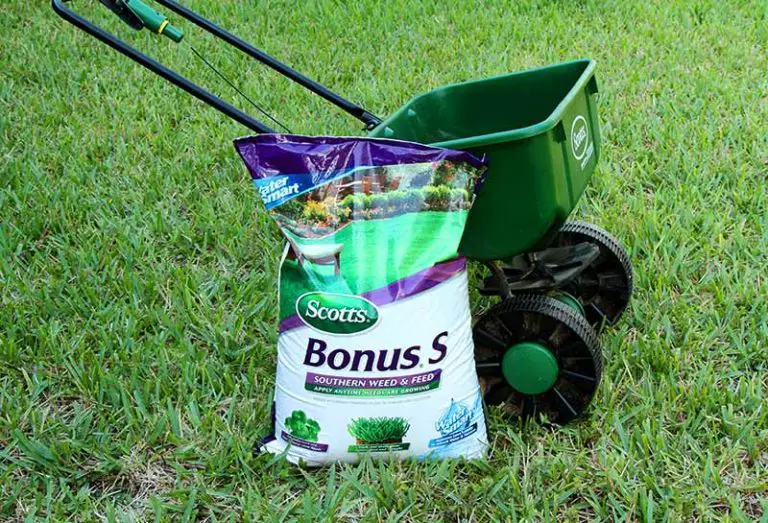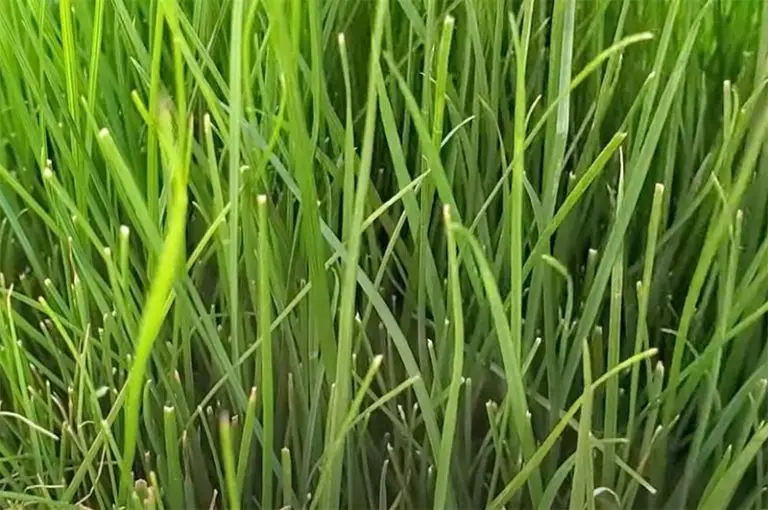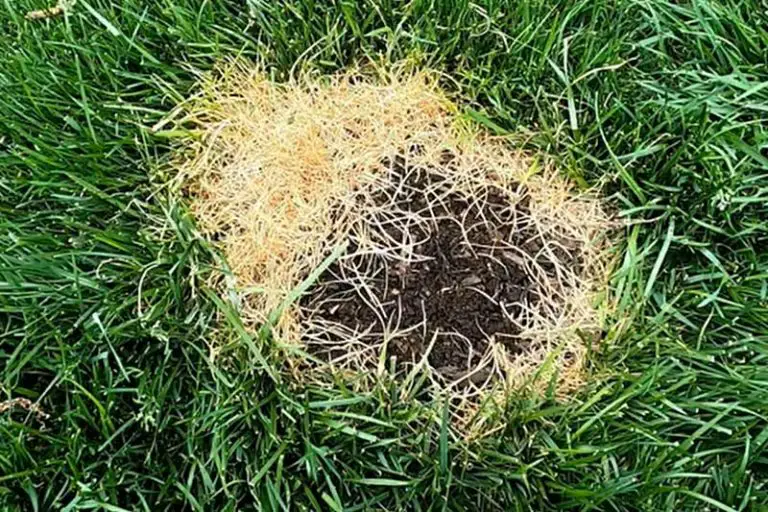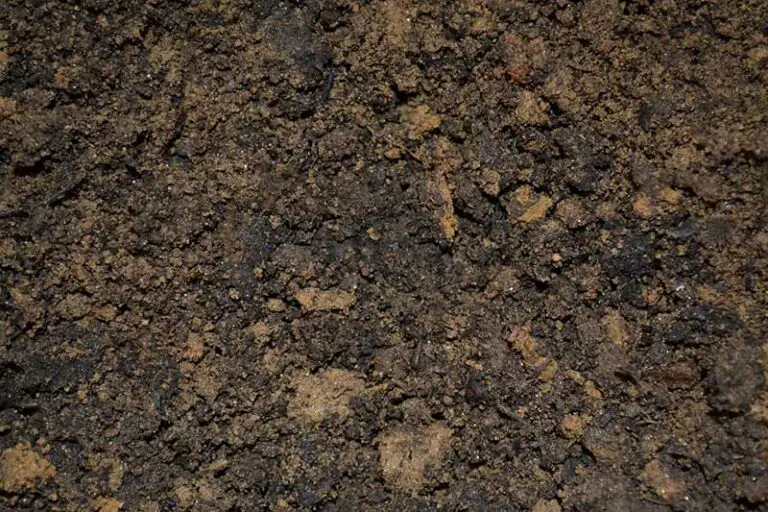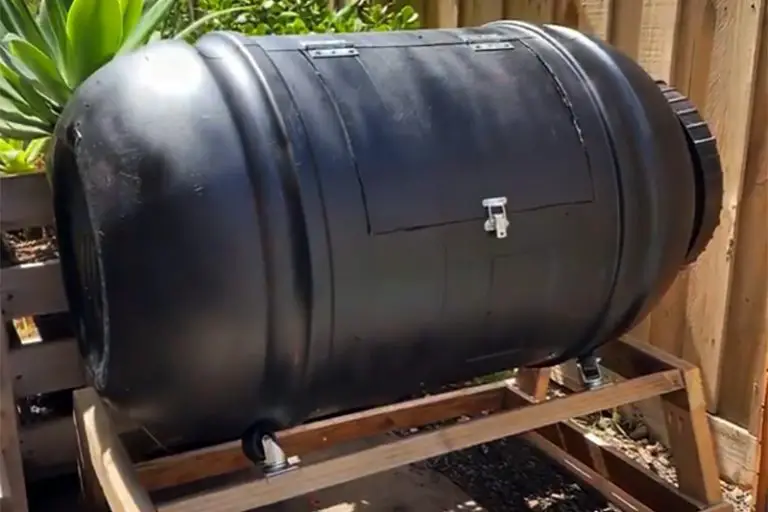When is the Best Time to Fertilize Lawn Before or After Rain?
When following a proper fertilization schedule, it’s inevitable that you will end up having to fertilize your lawn during a rainy season. Planning out your fertilization activities can be tricky when rain is involved, as wet grass affects the process in several ways.
The best time to fertilize a lawn during a rainy season is two days after it has rained, and at least two days before it’s forecast to rain again. With some types of fertilizer, it is possible to fertilize when the lawn is still partially wet. However, for most products, it’s best practice to wait until the lawn is dry before fertilizing.
This article explains everything you need to know about how wet grass can interfere with your fertilization efforts.
Why is it Important to Fertilize a Lawn?
Lawn fertilizers are amendments you can add to your lawn to enrich your soil and feed your grass with nutrients. A well-fertilized lawn helps your grass plants to grow thick, deep green foliage and strong, extensive root systems.
In turn, your lawn looks better and is more resistant to stress from extreme temperatures, drought, and pests. Having a thick lawn with a strong root system will also help to choke out weed growth; weeds have a much harder time competing against a well-fertilized lawn.
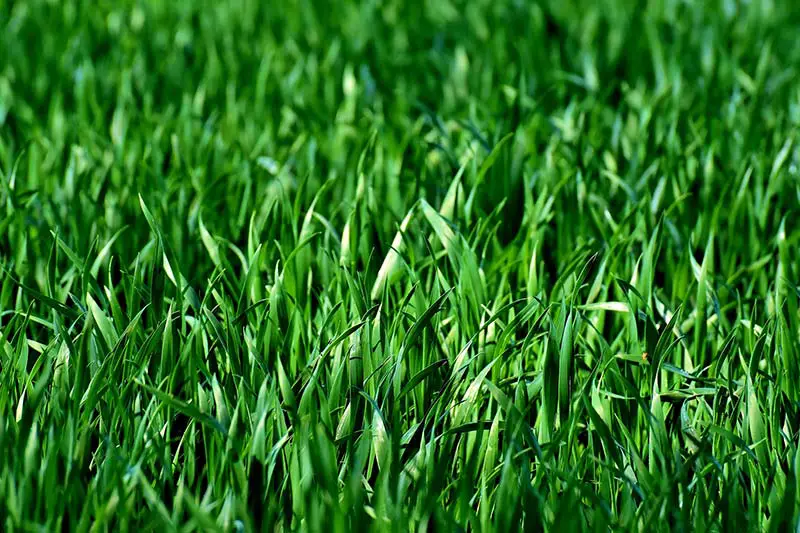
Understanding Lawn Fertilization
All fertilizers contain, in varying amounts, the three primary nutrients that plants need to grow. These three primary nutrients are nitrogen (N), phosphorus (P), and potassium (K). In grass, these three nutrients are used as follows:
- Nitrogen (N) is responsible for giving grass its green color and promotes the thick growth of the grass blades.
- Phosphorus (P) promotes the growth of strong, extensive root systems and helps new grass seeds to sprout.
- Potassium (K) promotes the grass plants’ resistance to stress from drought, disease, lawn fungus, extreme weather, and foot traffic.
Your grass plants have particular needs for certain nutrients depending on their stage of growth. For example, new grass seed has a higher requirement for phosphorus as it plays an important role in germination and the development of roots. Mature lawns, on the other hand, require more nitrogen, as this nutrient is responsible for lush, green foliage growth.
These nutrients, in addition to a number of other micronutrients, are essential for your lawn. While they are naturally present in soils, their abundance gradually decreases over time. This is when you can step in with fertilizer to add the missing nutrients back into your soil.
Understanding Different Types of Fertilizer
From NPK values to additional treatments, there is a huge range of lawn fertilizer products on the market. Because of this, you can find a fertilizer that is perfectly tailored to the needs of your lawn. There are four main aspects you need to consider when choosing the best lawn fertilizer for your grass:
NPK Values
The amount of each nutrient present in different fertilizers varies from product to product. To find out how much of each nutrient a certain fertilizer has, you can look at its NPK value; this is a number listed on the fertilizer’s packaging that represents how much nitrogen, phosphorus, and potassium it contains. For example, a typical NPK value for an all-purpose fertilizer would be 10-10-10. This means that the fertilizer contains 10% of each primary nutrient, with the rest being filler material.
Additional Treatments
On top of the primary nutrients, many lawn fertilizers also contain additional treatments to further strengthen your lawn. Some fertilizers offer preventative or control pesticides to combat common lawn pests, such as ants, chinch bugs, or grubs. If your lawn is susceptible to lawn fungus infestations, like brown patch disease, you can buy a fertilizer with an added fungicide. Weed and feed products are also available that contain pre or post-emergent weed killers for grassy weeds like crabgrass and nutsedge, or broadleaf weeds such as clover.
Organic vs Synthetic Fertilizers
After deciding what nutrients and treatments you want your fertilizer to contain, you then have to choose your type of fertilizer. Lawn fertilizers come as either synthetic chemical mixtures, or organic fertilizers made from natural sources of the nutrients. While organic fertilizers take longer to work, they keep fertilizing your soil for a longer time than synthetic fertilizers. Synthetic fertilizers tend to be cheaper, but have more damaging effects on the environment and are more likely to cause fertilizer burn.
Granular vs Liquid Fertilizers
There are two different forms that your fertilizer can come in; either as a dry, granular fertilizer or a liquid fertilizer. Granular fertilizers are made from nutrients in a powdered or pelleted form and work by breaking down gradually as you add water to your lawn. Liquid fertilizers are in a liquid form that your grass plants can readily take in. Although liquid fertilizers work more quickly to release their nutrients, granular fertilizers take longer to break down, thus enriching the soil for a longer period of time. With granular fertilizers, there is also less likelihood of overfertilizing or burning your lawn.
When is the Best Time to Fertilize a Lawn?
In general, the best time to fertilize a lawn is in the late afternoon. Fertilizing at this time allows your lawn to absorb the fertilizer’s nutrients out of the way of the hot sun. Doing so also helps to reduce the chance of fertilizer burn.
In terms of the time of year, how often you fertilize will ultimately depend on the area in which you live. You should carry out no more than four fertilizations throughout the year, following this rough schedule:
- First in early spring, when soil temperatures reach 55ºF
- Second in late spring, between April and June
- Third in summer, between June and August
- Fourth in fall, between August and November
It’s very likely that your fertilization schedule will necessitate you fertilizing during a rainy period at some point. So, it’s important to know how rain can affect the fertilization process, which we explain in the following sections.
Can You Fertilize Wet Grass?
In short, no, it’s inadvisable to attempt to fertilize wet grass. Wet grass interferes with fertilizer in several ways; it affects foliar absorption, causes an uneven distribution of the fertilizer in the soil, and results in loss of nutrients from leaching and runoff. Therefore, you should never fertilize wet grass when the lawn is sodden with water after heavy rain.
Reasons Why You Should Avoid Fertilizing Wet Grass
We have explained the reasons why you can’t fertilize wet grass effectively in more detail below.
1. Fertilizing Wet Grass Results in Nutrient Loss
Fertilizing wet grass is often ineffective as the extra water carries much of the nutrients away from your soil. After you apply them to your soil, fertilizers are still mobile. This means that they are affected by extreme weather conditions like heavy wind and rainfall; granular fertilizers may be moved by the wind, while both granular and liquid fertilizers are affected by heavy rainfall. If you fertilize your lawn while it’s wet, the water may carry away the nutrients as it drains from your soil. This will render your fertilization efforts pointless. Although this risk is greater with liquid fertilizers, granular fertilizers are also susceptible to the same issues.
2. Fertilizing Wet Grass Causes an Uneven Distribution of Nutrients
Another consequence of fertilizing wet grass is that the water may carry the fertilizer to different areas of the lawn. Even if you apply the fertilizer with precision, the water in the soil may cause it to shift. This causes certain sections of your grass to become overfertilized, while others end up with no fertilizer at all. As a result, you will see uneven growth throughout the lawn.
3. You May Attempt to Fertilize Again After Unsuccessfully Fertilizing Wet Grass
As we’ve just explained, fertilizing wet grass tends to leave you with a partially or completely unfertilized lawn. Your natural reaction to this may be to attempt another round of fertilization as soon as you realize the first attempt was unsuccessful; this, however, would likely be a bad move. Adding more fertilizer straight after fertilizing can leave your soil with more nutrients than it needs. This causes the lawn to become overfertilized, which ultimately leads to grass damage from fertilizer burn.
4. Fertilizer Leaching and Runoff Pollutes Nearby Environment
On top of harming your lawn, fertilizing wet grass can also cause problems for the environment and water bodies nearby. When your lawn is wet, the water drains out of your soil towards the nearest body of water. With the water goes all of the substances that your fertilizer contains, polluting nearby ponds, lakes, rivers, and streams. Synthetic fertilizers are the most damaging to the environment, as the chemicals can severely affect aquatic plant life and organisms. Even organic fertilizers can be harmful, as their nutrients can trigger unnatural algae blooms in ponds and lakes.
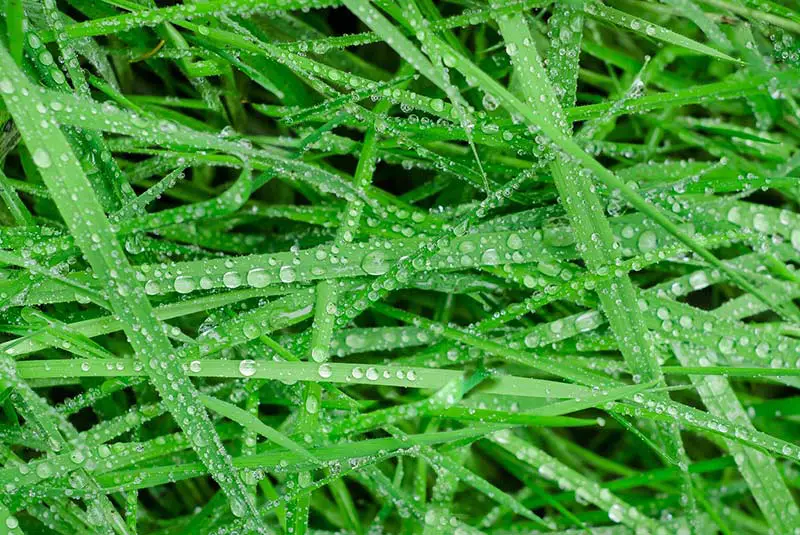
How Different Fertilizers Behave on Wet Grass
As we’ve explained, there are many types of fertilizers that differ in their application and behavior. The effect that your fertilizer will have on wet grass depends on the type that you’ve used.
Quick-Release Fertilizer
Quick-release fertilizer works the fastest to deliver its nutrients to your soil and grass plants. It comes in a format that plants like grass are able to take up readily. This type of fertilizer is very effective at producing noticeable results in a short amount of time.
However, it’s also one of the harshest types of fertilizer that can damage your lawn if you apply it incorrectly, or onto wet grass. The fast-releasing chemicals cause your grass plants to take in the fertilizer almost immediately. This causes the grass blades to become discolored and can lead to fertilizer burn in a matter of days. The damage may affect part or all of your lawn depending on where the fertilizer ends up in the highest concentrations.
Controlled-Release Fertilizer
Controlled-release fertilizers release their nutrients into the soil gradually, taking more time to work but fertilizing your soil for longer. They come as dry pellets that have a thick coating of resin, sulfur, and organic polymers. This coating slows down the fertilizer’s release of nutrients, preventing the fertilizer from releasing its nutrients all at once.
It takes a couple of weeks for controlled-release fertilizer to break down in the soil, subject to levels of water and sunlight. Therefore, if you apply it to wet grass, it will take a couple of weeks for the damage to show up. The damage will appear the same as that of quick-release fertilizer, discoloring the grass and ultimately causing fertilizer burn.
Granular Fertilizer
Granular fertilizers can either come as quick-release or slow-release formulas in a dry powdered or pelleted form. It’s typically best to apply granular fertilizer onto dry grass. Over time, the fertilizer breaks down from irrigation and rainfall, gradually releasing its nutrients.
If applied incorrectly or onto wet grass, it’s very possible for granular fertilizer to cause fertilizer burn. There is a bigger risk of this happening if you use a quick-release granular formula. It’s also a mistake to apply granular fertilizer to a dry lawn, adding water straight after to speed up the absorption process. This could cause your turf to suffer due to the extended contact that the fertilizer has with the grass blades. Therefore, it’s best to wait until any mist, fog, irrigation water, or rainwater has cleared before fertilizing with granular fertilizer.
Water-Soluble Fertilizer
Liquid or water-soluble fertilizers are fertilizers that come in a liquid format. They are taken up by grass plants more readily than granular fertilizers, working more quickly to release their nutrients. It’s typically best practice to apply liquid fertilizer to wet grass.
As liquid fertilizer is a more concentrated form of nutrients, it’s harsher on your grass plants. Therefore, if applied to a dry lawn, it’s likely that your liquid fertilizer will end up scorching the grass. With that said, it’s still best to avoid fertilizing your lawn with liquid fertilizer after heavy rainfall; this may cause the fertilizer to leach off before your lawn has a chance to absorb its nutrients.
Organic Fertilizer
Organic fertilizers are naturally occurring organic sources of the nutrients plants need to grow. They typically contain materials such as manure, plant fossils, compost, kelp, or fish pellets. It is possible to apply organic fertilizer to slightly wet grass.
This type of fertilizer takes longer to work, releasing its nutrients into the soil gradually as it naturally decomposes. Due to this process, it contains a lower concentration of nutrients and is less likely to burn your grass. This makes it possible to add organic fertilizer to your lawn when it’s slightly wet. You should still be wary that a heavy rainfall after application may cause the fertilizer to wash away.
Should You Fertilize Lawn Before or After Rain?
During a rainy period, the best practice is to fertilize your lawn two days after it has rained and at least two days before it is forecast to rain again. This gives your lawn a chance to dry out before the application, which is especially important when using a liquid or synthetic fertilizer. It also allows a few days after the application for your lawn to absorb as much of the fertilizer as possible before the next rain.
Fertilizing Lawn Before Rain
It’s the least effective method to fertilize your lawn within several days of a heavy rain forecast.
As we’ve already explained, fertilizing before rain is a bad idea for a few reasons; heavy rainfall leads to run-off, which carries your newly-added nutrients away from where you applied them. This causes certain areas of your lawn to be either over or under fertilized, leaving it partially or completely malnourished and/or burnt. Another knock-on effect is that the fertilizer ultimately ends up in nearby bodies of water, where it can be harmful to the environment and wildlife.
Fertilizing Lawn After Rain
Depending on the type of fertilizer you use, you can fertilize your lawn within days after a heavy rainfall.
If fertilizing the lawn after rain, you need to wait until the lawn is slightly damp to completely dry before applying your fertilizer. Liquid and organic fertilizers are safe to use when the lawn is slightly damp; for most other fertilizer products, you need to give the lawn a chance to dry out before application. Before fertilizing, check the weather forecast and make sure there is no heavy rain forecast with the next few days.
Tips For Fertilizing After Rain
Here are some general tips to follow when attempting to fertilize your lawn during a rainy season.
Time it Right
To summarize what we’ve already discussed, timing is key when planning how to fertilize a lawn before or after rain. You should wait two days after heavy rainfall, and at least two days before more rain is forecast. In an ideal scenario, it’s best to fertilize when it’s also forecast to be sunny for the following days.
If using a liquid or organic fertilizer, wait until the grass is partially dry before fertilizing. For most other types of fertilizer, it will be necessary to wait until the grass is completely dry before application. As a rule of thumb, never fertilize a saturated lawn, regardless of what type of fertilizer you use.
Use Organic Fertilizer
For best long-term results, you should use a slow-release organic fertilizer on your lawn. Due to its slow decomposition process, organic fertilizer is much more gentle on your grass when you first apply it. It takes longer to fertilize your lawn, but the risk of fertilizer burn is greatly reduced, especially during wet weather. It also keeps fertilizing your lawn for much longer after you apply it in comparison to synthetic fertilizer.
On top of this, the potential negative effects of organic fertilizers on the local environment are a fraction of the risks that come with synthetic fertilizers. Using organic fertilizer to fertilize before or after rain means you don’t need to worry about harmful chemical runoff.
Keep Grass Long
Keeping your grass long is a good practice for your lawn in general. When your grass is longer, your grass plants have more surface area on their blades; this improves their overall health as it provides them with a bigger surface to photosynthesize. The longer blades also help to choke out weed growth.
Follow a proper mowing schedule, but adjust your mower deck so that you’re cutting the grass as long as possible. Generally speaking, you should cut the grass to a height of about 3 to 4 ½ inches tall. As an additional side note, you should always avoid mowing wet grass; not only would this be dangerous to your health, it could also stress out your grass plants and leave your lawn more susceptible to disease.
Leave Grass Clippings on Lawn
Another good general lawn practice is to leave the grass clippings on the lawn after mowing. Grass blades left on the lawn act as a natural fertilizer and compost, enriching the soil with nitrogen as they break down.
In addition to this, the grass clippings also act as a mulch to protect your soil and reduce the evaporation of water. Although this may seem counterintuitive for this article, improving your soil’s water retention in turn helps to reduce soil compaction. This allows your soil to better absorb any fertilizer or treatments you apply to it throughout the year.

